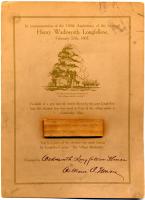To understand Henry Wadsworth Longfellow's extraordinary popularity in the 19th century -- the most popular living author then and the most widely read American poet who ever lived -- it is necessary to understand America at that time.
Longfellow was born after the Revolutionary War, but grew up hearing stories about the war. He was five years old during the War of 1812 and a schoolboy when educators were teaching what it meant to be an American.
He wrote his poetry during an era of drastic change in America.
The mid 19th century brought urban growth, immigration, and fierce market competition.
The discovery of gold in California in 1849 and the building of railroads contributed to the opening of the West.
Social movements -- women's rights, abolition, and temperance -- led to further change and disruption.
The tensions surrounding the American Civil War and the issue of slavery culminated in the assassination of President Abraham Lincoln in 1864.
Longfellow was the common man's poet. His poems addressed the life experiences of readers in a changing world.
He understood and was understood by the masses.
Dramatic improvements in print technology and book distribution in the pre Civil War period were significant to Longfellow's success as a poet.
The antebellum years, which have been called the "American Renaissance," produced Emerson, Thoreau, Hawthorne, Poe, Whitman, Dickinson, and Longfellow.
Victorian Americans were hungry to read poetry, which they believed was the highest literary form.
The market also was filled with seamy fiction, brash American humor, and accounts of crime in cheap editions known as "penny dreadfuls."
Longfellow, who understood the cultural nuances of his time, successfully used the new publishing opportunities.

Departure of Hiawatha, ca. 1868
Item 15899 infoNPS, Longfellow House-Washington's Headquarters National Historic Site
Longfellow believed in the poet's role as teacher and moral arbiter, but he also was a good businessman.
His contracts with publishers were lucrative and he carefully monitored his sales figures.
As a result, he was able to make a living from his writing. In 1854, he resigned from his position at Harvard and became America's first, full-time professional poet.
The response to Longfellow's poetry was phenomenal. Thousands of copies of his best-known works sold within weeks of publication and went through many subsequent printings and editions.
He wrote what people wanted to hear and what they thought a poet should write, connecting with America's rising, unsophisticated middle class.
Longfellow has been called the "most versatile American poet of his century."
A gifted lyric poet, he infused his works with musicality and atmosphere, but also had a genius for writing narrative poetry.
He was a superb storyteller who once described himself as "a kind of arrant poacher in the rich fields of legend and romance."
Longfellow and other educated Americans saw the need to create a national literature that would reflect the unique history and evolving character of their countrymen.
Longfellow believed that American literature could not ignore its European roots and he drew on his deep knowledge of European literature and of dozens of poetic forms gained from his experiences as a linguist and translator.
Still, his subject matter was American.
Although Longfellow rarely addressed political issues in his poetry, he drew on American culture, experience and history.
However, he was not a historian. He created myths and classic epics from American historical events and materials -- Native American oral history (The Song of Hiawatha), the diaspora of Acadians (Evangeline), Plymouth's Pilgrim colony (The Courtship of Miles Standish), and the first battle of the Revolutionary War ("Paul Revere's Ride").
He reminded Americans of their roots and in the process became an American icon himself.
Longfellow has been called the "Children's Poet" because his vivid storytelling captured the imagination of children and his musical lines lent themselves to memorization.
His portrait, like those of George Washington and Abraham Lincoln, was a fixture in schoolrooms.
The first lines of "Paul Revere's Ride" -- "Listen my children, and you shall hear, Of the midnight ride of Paul Revere" -- probably are the most often quoted by adult Americans, even today.
Longfellow had been a happy child in a house full of children and was the father of six children.
He immortalized his daughters, "Grave Alice, and laughing Allegra, And Edith with golden hair" in "The Children's Hour."
Prints of Thomas Buchanan Reed's 1859 portrait of the girls were widely sold.

The Chestnut Chair, ca. 1876
Item 15476 infoNPS, Longfellow House-Washington's Headquarters National Historic Site
When the "spreading chestnut tree" that inspired his paean to the village blacksmith of Cambridge was cut down so a road could be widened, local school children contributed their pennies toward a chair made from its wood.
They presented it to Longfellow on his 73rd birthday.
Longfellow kept the chestnut tree chair in his Craigie House study, where it still stands.
Craigie House is now a National Historic Site devoted to Longfellow.
Children also raised money for Portland's Longfellow Monument, a seated statue of the poet.
The statue, erected in 1888, was created by sculptor Franklin Simmons.
Portland's Longfellow School, on Stevens Avenue, is one of many schools across the country to bear the poet's name, lasting tributes to the man whose poetry connected children to their historic roots.














